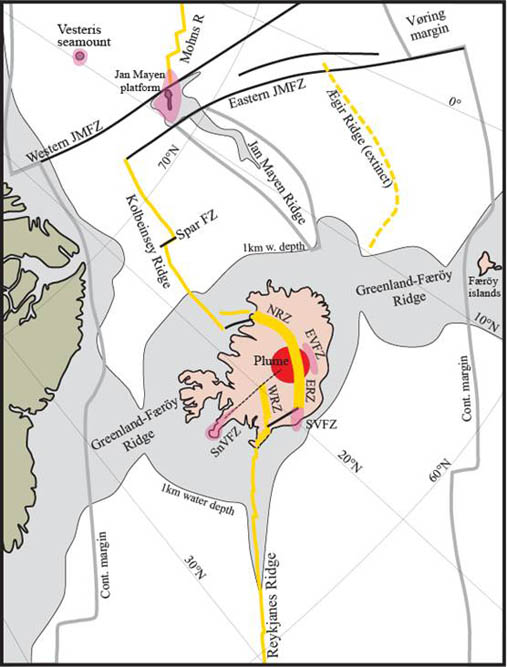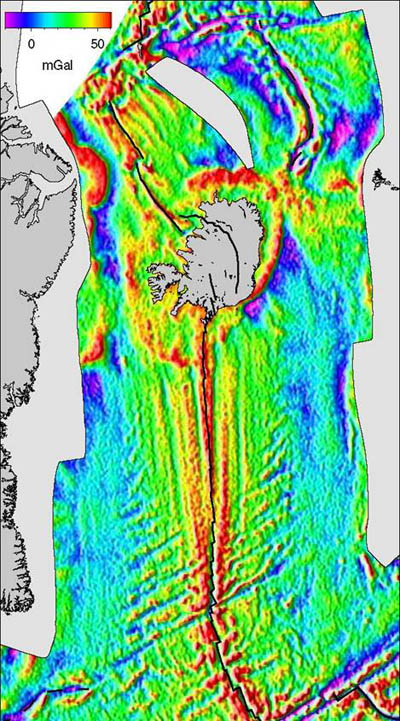NHM researcher: Reidar G. Trønnes
Associated researchers: V. Debaille, T.E. Waight
Whereas primitive alkaline basalts from Jan Mayen and Icelandic off-rift zones represent low-degree melts from the fertile parts of the NE Atlantic mantle, the olivine tholeiites from Icelandic rift zones and nearby oceanic spreading ridges are formed by protracted decompressional melting. The V-shaped ridges along the Reykjanes, Kolbeinsey and Aegir axes indicate that ascending source material is supplied by a pulsating plume and deflected laterally for distances of about 1000 km from Iceland. Plume material deflected in the direction of the rift zones and spreading ridges undergoes extensive melting at shallow level, whereas material deflected in other directions flows laterally at deeper levels and remains largely unmelted and more fertile.
Our ongoing geochemical investigation, including Sr-Nd-Pb-He-Os-isotope ratios, of a suite of primitive off-rift basalts from Iceland and Jan Mayen (Debaille et al., 2009) has demonstrated an important contribution of subcontinental lithospheric mantle (SCLM) to the magmas. A compilation of our new data on the primitive off-rift basalts and existing data on the tholeiitic basalts from Iceland and nearby oceanic ridges indicates the existence of three main composite mantle components, characterized by the following relative isotope ratios (H: high, I: intermediate and L: low ratio) for 87Sr/86Sr, 143Nd/144Nd, 206Pb/204Pb, 187Os/188Os og 3He/4He, respectively:
1. Iceland plume component: I, I, H, H, H (a composite mix of depleted lower mantle + recycled oceanic crust)
2. Strongly depleted and later re-enriched SCLM: H, L, I, L, L
3. Depleted asthenosphere: L, H, L, I, L
Each of these composite components contains enriched and depleted subcomponents with their own isotope signatures. The isotope ratio differences are larger between the fertile components than between the refractory components. The 3He/4He ratio, however, is much higher in the depleted plume component than in the depleted SCLM and asthenospheric components. The old SCLM material could in principle be recycled and embedded in the lower mantle and supplied to the melting zone by the Iceland plume. However, the regional isotopic variation pattern indicates that this material originated from the nearby continents and became delaminated and embedded in the upper mantle during the continental separations of Greenland and Norway (55 Ma), Greenland and the continental Jan Mayen Ridge (35 Ma) and Greenland and Spitsbergen (35 Ma). The influence of fertile and refractory SCLM is clearly recognized in the northern region, including Jan Mayen, the Kolbeinsey, Mohns, Knipovich and Gakkel Ridges and the Northern Rift Zone in Iceland. The contribution of fertile and refractory SCLM to the melt generation is especially strong near the Jan Mayen Ridge and at the Gakkel Ridge close to the Yermak Plateau, but considerably weaker for the Snæfellsnes Peninsula, the Mid-Icelandic Belt and the Western and Eastern Rift Zones, and even weaker for basalts from Vestmannaeyjar, the Southern Volcanic Flank Zone, the Reykjanes Peninsula and the Reykjanes Ridge. The large-scale geographical-geochemical pattern have important implications for the delamination and entrainment of SCLM in the upper mantle asthenoshere and the interaction of plume flow and the asthenosphere.
Whereas primitive alkaline basalts from Jan Mayen and Icelandic off-rift zones represent low-degree melts from the fertile parts of the NE Atlantic mantle, the olivine tholeiites from Icelandic rift zones and nearby oceanic spreading ridges are formed by protracted decompressional melting. The V-shaped ridges along the Reykjanes, Kolbeinsey and Aegir axes indicate that ascending source material is supplied by a pulsating plume and deflected laterally for distances of about 1000 km from Iceland. Plume material deflected in the direction of the rift zones and spreading ridges undergoes extensive melting at shallow level, whereas material deflected in other directions flows laterally at deeper levels and remains largely unmelted and more fertile.
Our ongoing geochemical investigation, including Sr-Nd-Pb-He-Os-isotope ratios, of a suite of primitive off-rift basalts from Iceland and Jan Mayen (Debaille et al., 2009) has demonstrated an important contribution of subcontinental lithospheric mantle (SCLM) to the magmas. A compilation of our new data on the primitive off-rift basalts and existing data on the tholeiitic basalts from Iceland and nearby oceanic ridges indicates the existence of three main composite mantle components, characterized by the following relative isotope ratios (H: high, I: intermediate and L: low ratio) for 87Sr/86Sr, 143Nd/144Nd, 206Pb/204Pb, 187Os/188Os og 3He/4He, respectively:
1. Iceland plume component: I, I, H, H, H (a composite mix of depleted lower mantle + recycled oceanic crust)
2. Strongly depleted and later re-enriched SCLM: H, L, I, L, L
3. Depleted asthenosphere: L, H, L, I, L
Each of these composite components contains enriched and depleted subcomponents with individual isotope signatures. The isotope ratio differences are larger between the various fertile components than between the refractory components. The 3He/4He ratio, however, is much higher in the depleted plume component than in the depleted SCLM and asthenospheric components. The old SCLM material could in principle be recycled and embedded in the lower mantle and supplied to the melting zone by the Iceland plume. However, the regional isotopic variation pattern indicates that this material originated from the nearby continents and became delaminated and embedded in the upper mantle during the continental separations of Greenland and Norway (55 Ma) and of Greenland and the continental Jan Mayen Ridge (25 Ma). The contribution of fertile and refractory SCLM to the melt generation is strongest in the north (Jan Mayen, Mohns Ride, Kolbeinsey Ridge and the Northern Rift Zone in Iceland), slightly weaker for basalts from the Snæfellsnes Peninsula, the Mid-Icelandic Belt and the Western and Eastern Rift Zones, and even weaker for basalts from Vestmannaeyjar, the Southern Volcanic Flank Zone, the Reykjanes Peninsula and the Reykjanes Ridge. The large-scale geographical-geochemical pattern may have important implications for the delamination and entrainment of SCLM in the upper mantle asthenoshere and the interaction of plume flow and the asthenosphere.
 Fig. 1 Geologic and bathymetric features of the NE Atlantic . Abbreviations: JMFZ, Jan Mayen Fracture Zone; FZ, Fracture Zone; SnVFZ, Snæfellsnes Volcanic Flank Zone; SVFZ, southern Volcanic Flank Zone; WRZ, Western (Volcanic) Rift Zone; ERZ, Eastern (Volcanic) Rift Zone; NRZ, Western (Volcanic) Rift Zone. The Jan Mayen Ridge represents a continental sliver rifted off from the eastern continental margin of Greenland about 25 Ma. (Mosar et al. 2002).
Fig. 1 Geologic and bathymetric features of the NE Atlantic . Abbreviations: JMFZ, Jan Mayen Fracture Zone; FZ, Fracture Zone; SnVFZ, Snæfellsnes Volcanic Flank Zone; SVFZ, southern Volcanic Flank Zone; WRZ, Western (Volcanic) Rift Zone; ERZ, Eastern (Volcanic) Rift Zone; NRZ, Western (Volcanic) Rift Zone. The Jan Mayen Ridge represents a continental sliver rifted off from the eastern continental margin of Greenland about 25 Ma. (Mosar et al. 2002).
 Fig. 2. Diachronous V-shaped ridges along the Reykjanes, Kolbeinsey and Ægir spreading axes as seen in f ree-air gravity field from satellite altimetry (from Jones et al. 2002) . The classic V-ridges are best developed along the Reykjanes ridge. Here the migration rate of the causative plume pulses of hot/fertile material moving southwards is about 25 cm/a. The ridges east of the northern half of the Kolbeinsey Ridge appear to be more parallel with the spreading axis, possibly indication a slightly higher northward migration rate. In contrast, the V-shaped ridges along the older and now extinct Ægir axis forms a larger angle of 45º (east side) to 90º (west side) with the spreading axis, indicating northeastern migration rate of 3-6 mm/a (Breivik et al. 2006).
Fig. 2. Diachronous V-shaped ridges along the Reykjanes, Kolbeinsey and Ægir spreading axes as seen in f ree-air gravity field from satellite altimetry (from Jones et al. 2002) . The classic V-ridges are best developed along the Reykjanes ridge. Here the migration rate of the causative plume pulses of hot/fertile material moving southwards is about 25 cm/a. The ridges east of the northern half of the Kolbeinsey Ridge appear to be more parallel with the spreading axis, possibly indication a slightly higher northward migration rate. In contrast, the V-shaped ridges along the older and now extinct Ægir axis forms a larger angle of 45º (east side) to 90º (west side) with the spreading axis, indicating northeastern migration rate of 3-6 mm/a (Breivik et al. 2006).
References
- Breivik, A. J., Mjelde, R., Faleide, J. I., and Murai, Y., 2006. Rates of continental breakup magmatism and seafloor spreading in the Norway Basin-Iceland plume interaction. J. Geophys. Res. 111, B07102, doi:10.1029/2005JB004004.
- Debaille, V., Trønnes, R.G, Brandon, A.D., Waight, T.E., Graham, D., Lee, C.-T.A., 2008, Primitive off-rift basalts from Iceland and Jan Mayen: Os-isotopic evidence for a mantle source containing enriched subcontinental lithosphere. Geochim.Cosmochim. Acta., resubmitted after revisions, Feb. 2009.
- Jones, S. M., White, N., and Maclennan, J., 2002. V-shaped ridges around Iceland: Implications for spatial and temporal patterns of mantle convection. Geochem. Geophys. Geosyst. 3, 1059, doi:10.1029/2002GC000361.
- Mosar, J., Eide, E., Osmundsen, P. T., Sommaruga, A., and Torsvik, T. H., 2002. North Atlantic sea-floor spreading rates: implications for the Tertiary development of inversion structures of the Norwegian-Greenland Sea. J. Geol. Soc. 159, 503-515.
- Trønnes, R.G., Planke, S., Sundvoll, B. & Imsland, P., 1999: Recent volcanic rocks from Jan Mayen: Low-degree melt fractions of enriched northeast Atlantic mantle. J. Geophys. Res. 104, 7153-7168.